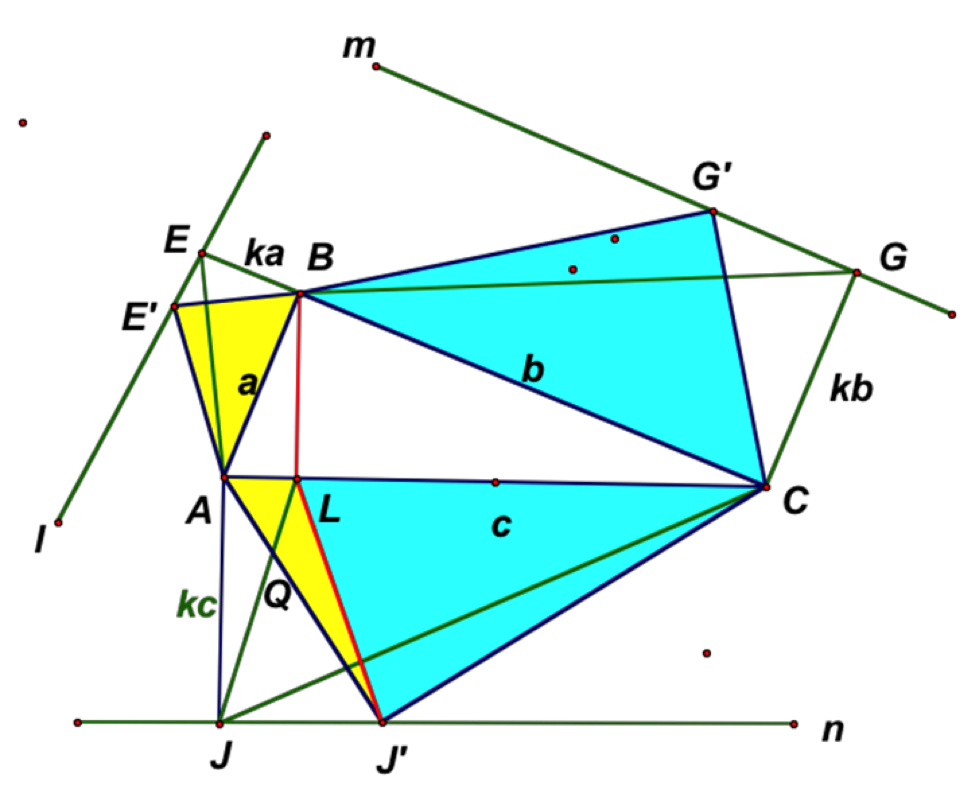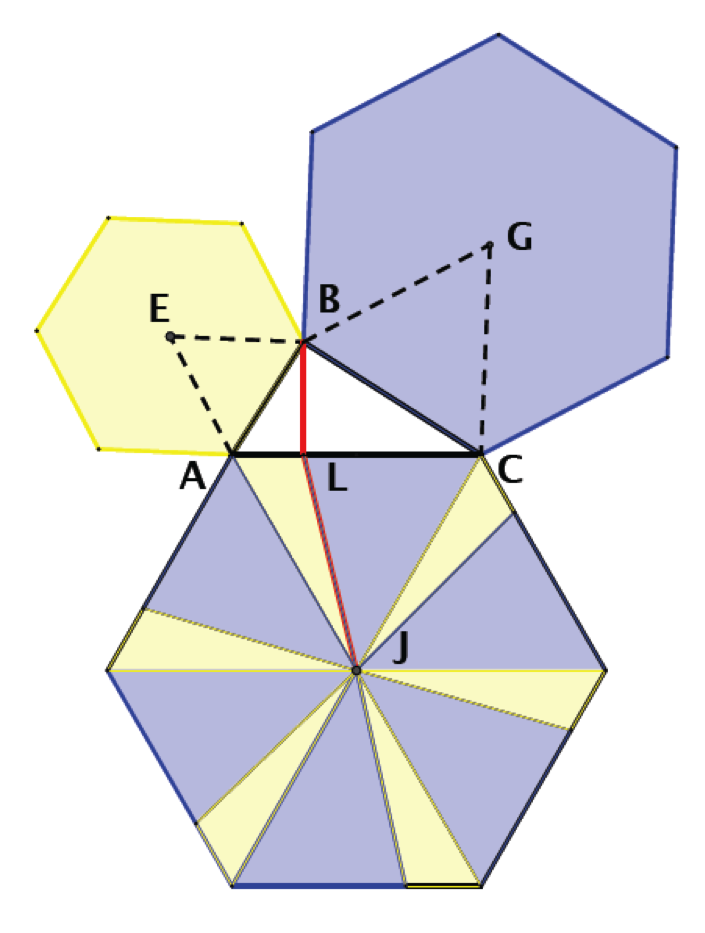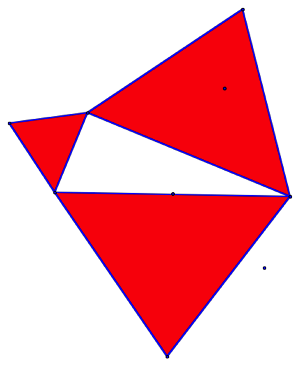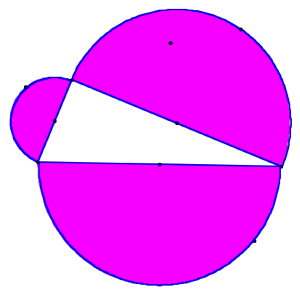Pythagorean Cuts
Overview
During the third century BCE, Euclid of Alexandria made the Theorem of Pythagoras (and its converse) the climax of Book I of his Elements of Geometry. Euclid stated the theorem geometrically, as a theorem about three squares built on the sides of a right triangle. His proof consisted of cutting the square on the hypotenuse into two rectangles, each having area equal to that of one of the remaining squares on the sides. Can Euclid's "Pythagorean cut" be adapted to parallelograms, triangles, n-gons, and semicircles built on the sides of a right triangle? To find out, read on!
Pythagorean Cuts – Introduction
The Theorem of Pythagoras is arguably the most famous theorem in all of mathematics. There is evidence that the relationship between the lengths of the sides of a right triangle has been known to virtually every culture across time and geography. While many proofs have been published by, or attributed to, various sources and persons, the proof presented by Euclid of Alexandria ca. 280 BCE remains unmatched in its simplicity and elegance. In his Elements, Book I, Prop. 47 (I.47), Euclid stated the relationship between sides of the triangle purely geometrically:
Let right triangle ABC be given with the right angle at B. If squares are constructed on each of the sides, then the sum of the areas of the square on AB and the square on BC equals the area of the square on AC (see Figure 1, below).

Figure 1: The Theorem of Pythagoras from Euclid's Elements. The "Pythagorean cut," line segment LK, is shown in red.
Euclid's proof was purely geometric (see Figure 1): He showed that segment BK divides the largest square AJHC into two rectangles, each of which has the same area as one of the smaller squares.
In more modern notation, Euclid I.47 says this:
Given a right triangle with sides of lengths \(a, b,\) and \(c,\) with \(c\) as the longest side, then
\[a^2 + b^2 = c^2.\]
Algebraically, for any positive constant \(k,\) this equation generalizes as follows: \[ka^2 + kb^2 = kc^2.\] One can’t help but notice that different values of \(k\) correspond to different geometric interpretations. For example, \(k ={\frac{1}{2}}\) corresponds to "1 by 2" rectangles, rather than squares, being constructed on each side of the right triangle. Likewise, the value of \(k ={\frac{\sqrt 3}{4}}\) corresponds to equilateral triangles being constructed on each side. Similarly, \(k ={\frac{\pi}{8}}\) corresponds to semicircles being constructed on each side, with the radius equal to half of the length of the side of the triangle on which it is constructed (see Figure 2, below).
|
|
|
|
Figure 2: The Pythagorean Theorem generalized to rectangles, triangles, and semi-circles
The equation \[ka^2 + kb^2 = kc^2\] suggests that the Pythagorean relationship holds for any three similar figures constructed on the three sides of a right triangle. However, Euclid's Elements was written a thousand years before algebraic language would appear and about eighteen hundred years before there was a workable algebraic notation. This led us to wonder:
Can the Pythagorean relationship still be demonstrated geometrically for figures other than squares?
More specifically, how could the largest of the three figures be naturally partitioned, or cut, into two regions, each having area equal to that of one of the two smaller figures?
Pythagorean Cuts – Euclid's Proof
Before exploring adaptations of Euclid’s strategy to figures other than squares, let's recall his proof. We repeat Figure 1 for convenience.

Figure 1 (repeated from the preceding page): The Theorem of Pythagoras from Euclid's Elements with the "Pythagorean cut," line segment LK, shown in red.
Euclid showed how to partition the largest square in Figure 1, above, into two rectangles so that each rectangle would have the same area as one of the two smaller squares. The proof is essentially this. Drop a perpendicular from B to JH hitting JH at K and AC at L and draw construction lines DC and BJ (see Figure 1). Then triangle DAC is congruent to triangle BAJ by SAS and so the two triangles have the same area. Moreover, the area of triangle DAC is half the area of square BADE since they share the same base DA and have the same altitude AB. Likewise, the area of triangle BAJ is half the area of rectangle AJKL since they share the same base AJ and have the same altitude AL. Thus, the area of square BADE must be the same as the area of rectangle AJKL. Similarly, the area of square CGFB equals the area of rectangle LKHC based on congruent triangles ACG and BCH. So, segment BK partitions, or cuts, the largest square into two rectangles, each of which has area equal to the area of one of the other two squares. We say that segment LK is the “Pythagorean cut” for square AJHC. The Pythagorean cut, separating the largest square into two figures each of which has area equal to one of the two smaller squares, is shown in red in Figure 1.
Underlying Euclid's proof is his simple but profound observation in I.35 [Heath, p. 326]:
Parallelograms which are on the same base and in the same parallels are equal to one another.
From here, it is a fairly easy path to these two key observations:
Triangles which are on the same base and in the same parallels are equal to one another. (I.37 [Heath, p. 332])
If a parallelogram have the same base with a triangle and be in the same parallels, the parallelogram is double of the triangle. (I.41 [Heath, p. 338])
For example, in Figure 1, using lines through EC and DA as the parallels, triangle DAC and square DABE certainly fit the criteria in I.41.
Pythagorean Cuts – Rectangles and Other Parallelograms
In Figure 3, below, right triangle ABC with right angle at B is given with side lengths \(a, b,\) and \(c\) as shown. Rectangles are constructed on each side so that the width of the rectangles is the side length multiplied by some positive constant \(k,\) \(k\not=1\) (in Figure 3, \(k\) is about \(0.4\)). Can rectangle AJHC be divided up, or partitioned, in a natural way to illustrate the equation \[ka^2 + kb^2 = kc^2\] geometrically? In particular, can we proceed much as Euclid did for squares?

Figure 3: Similar rectangles on the sides of a right triangle. The Pythagorean cut, LK, is shown in red.
Following Euclid's proof of the Pythagorean Theorem, let BK be perpendicular to JH at K and intersect AC at L; draw construction lines DC and BJ, shown in green in Figure 3, above. We notice two things right away, one the same and one different from the situation in I.47 in which squares are drawn on the three sides. First, since triangle DAC and rectangle DABE share the same base DA and are in the same parallels with altitude AB, the area of rectangle DABE is twice the area of triangle DAC. Similarly, the area of rectangle AJKL is twice the area of triangle JAB. And second, although triangles DAC and JAB have a pair of congruent angles (JAB and DAC), the triangles are not congruent, since DA = JA only if \(a = c,\) which is impossible since \(c\) is the length of the hypotenuse, and AJ = AC only if \(k =1,\) which was not an option.
Even though triangle DAC is not congruent to triangle JAB, how do their areas compare? Triangle DAC, with base DA \(= ka\) and altitude AB \(= a,\) has area \({\frac{1}{2}}ka^2.\) Since the right triangles ALB and ABC are similar, we have \({\frac{AL}{a}}={\frac{a}{c}}.\) Hence, \(c\,AL = a^2,\) so that the area of triangle JAB is
\[{\frac{1}{2}}kc\,AL ={\frac{1}{2}}ka^2.\]
Thus, even though the two triangles are not congruent,
Area of triangle DAC = Area of triangle JAB,
so that
Area of rectangle DABE = Area of rectangle AJKL.
Similarly, we have
Area of rectangle BCGF = Area of rectangle KHCL,
so that
Area of rectangle ACHJ = Area of rectangle BCGF + area of rectangle DABE.
As in Euclid I.47, if point L is the foot of the perpendicular from B to AC, segment LK, perpendicular to hypotenuse AC (and parallel to rectangle side AJ), gives the natural partition of rectangle ACHJ. Thus, LK, shown in red in Figure 3, above, is the Pythagorean cut of rectangle ACHJ. A GeoGebra applet showing the Pythagorean cut for similar rectangles is given in Figure 4, below.
Figure 4: Pythagorean cut for similar rectangles
Please note that if similar parallelograms, rather than similar rectangles, were constructed on the sides of right triangle ABC, with point L determined as before and LK again the segment parallel to side AJ (see Figure 5, below), then the Pythagorean relationship among the areas of these parallelograms is still valid. That is,
Area of parallelogram AJKL = Area of parallelogram EDAB
and
Area of parallelogram LKHC = Area of parallelogram BCGF,
so that
Area of parallelogram EDAB + area of parallelogram BCGF = Area of parallelogram AJHC.
Again, LK is the Pythagorean cut for parallelogram ACHJ.

Figure 5: Similar parallelograms on the sides of a right triangle. The Pythagorean cut, LK, is shown in red.
Pythagorean Cuts – Triangles
Let similar right triangles ABE, BCG, and CAJ be constructed on the three sides of right triangle ABC with EB \(= ka,\) CG \(= kb,\) and AJ \(= kc,\) for some positive constant \(k,\) as shown in Figure 6, below.

Figure 6: Similar right triangles on the sides of a right triangle. Line segment LJ is the Pythagorean cut.
Although our result will follow directly from the case of rectangles (and I.41), our goal here is to determine the Pythagorean cut. As before, let L be the foot of the perpendicular from B to AC and draw LJ. Let rectangles ABED, BCGF, and CAJH be formed on right triangles ABE, BCG, and CAJ, respectively. Since we know that the area of rectangle ABED equals the area of rectangle AJKL, half of these areas are still equal to one another. Thus,
area of triangle ABE = area of triangle ALJ,
and similarly,
area of triangle BCG = area of triangle CJL.
Then
area of triangle ABE + area of triangle BCG = area of triangle AJC
and segment LJ is the Pythagorean cut for right triangle AJC.
Suppose now that any three similar triangles are constructed on the sides of right triangle ABC with triangle AE'B on side AB; triangle BG'C on side BC; and triangle CJ'A on side AC (see Figure 7, below).

Figure 7: Similar triangles on the sides of a right triangle. Line segment LJ' is the Pythagorean cut.
Similar to the case for constructing right triangles, the result will follow from the preceding result and I.37, but finding the Pythagorean cut requires a bit more care. Let lines l, m, and n be parallel to sides AB, BC, and AC, respectively, as shown, and let segment LJ' be drawn. From Euclid I.37, we know that triangles with the same base and in the same parallels (with equal altitudes) are equal in area. Thus,
Area of triangle AE'B = Area of triangle AEB;
Area of triangle BG'C = Area of triangle BGC;
and
Area of triangle CJ'A = Area of triangle CJA.
Since triangles ALJ and ALJ' have the same base (AL) and are in the same parallels (with altitude AJ),
Area of triangle ALJ = Area of triangle ALJ'.
Since we know that
Area of triangle AEB = Area of triangle ALJ,
we have
Area of triangle AE'B = Area of triangle ALJ'.
Similarly,
Area of triangle BG'C = Area of triangle CJ'L.
Thus,
Area of triangle ABE' + Area of triangle BCG' = Area of triangle ACJ',
and segment LJ' is the Pythagorean cut for triangle AJ'C.
Pythagorean Cuts – Semicircles: A Special Case
Let triangle ABC be a 30-60 right triangle with hypotenuse AC and shortest side AB \(= 1\) (see Figure 8, below). Let semicircles be constructed on each side of triangle ABC.

Figure 8: A special case of semicircles. The Pythagorean cut is semicircle LMK, shown in red.
The semicircle on AB has radius \(\frac{1}{2}\) and so has area \({{\frac{1}{2}}\pi\left({{\frac{1}{2}}}\right)^2,}\) or \(\frac{\pi}{8}.\) Similarly, the area of the semicircle on side BC is \(\frac{3\pi}{8}\) and the area of the semicircle on hypotenuse AC is \(\frac{\pi}{2}\). Since \(\frac{\pi}{8}+\frac{3\pi}{8}=\frac{\pi}{2},\) the Pythagorean relationship holds:
Area of semicircle on AB + Area of semicircle on BC = Area of semicircle on AC.
Now let LK be the segment of length 1 perpendicular to AC and let the semicircle be constructed having diameter LK as shown. Since AB = LK, the semicircles on AB and on LK must have the same area of \(\frac{\pi}{8}.\) Moreover, since quarter circle AKL has area one-half the area of semicircle AKC, the area of quarter circle AKL is \(\frac{\pi}{4}.\) Thus,
Area of region ALMK \(=\frac{\pi}{4}-\frac{\pi}{8}=\frac{\pi}{8}\) = Area of semicircle on side AB,
and so semicircle LMK is a Pythagorean cut for semicircles built on the 30-60 right triangle. A GeoGebra applet showing the Pythagorean cut for semicircles with their diameters along the sides of this special right triangle is shown in Figure 9, below.
Figure 9. Semicircles with diameters along the sides of a 30-60 right triangle
Pythagorean Cuts – Extensions to Regular Polygons
Extensions to Regular Polygons
Can the notion of Pythagorean cuts be extended to, say, regular n-gons? Consider, for example, the regular hexagons built on the sides of right triangle ABC, as shown in Figure 10, below.

Figure 10: Regular hexagons on the sides of a right triangle. Line segment LJ, shown in red, is one of six line segments forming a sort of generalized Pythagorean cut.
Can the hexagon on AC be divided into two parts each having area equal to that of one of the hexagons on AB and BC? Knowing how to divide triangles in this way gives us a way to divide the hexagon on AC into two sets of six pieces each, so that the areas of the pieces in each set add up to the area of the hexagon on AB or BC. If BL is perpendicular to AC, we know that LJ is a Pythagorean cut for equilateral triangle AJC, so that the area of triangle ALJ equals the area of triangle AEB. Marking off a segment equal to AL on each side of the hexagon with center J ensures that the sum of the areas of the triangles shaded in yellow in hexagon J will equal the area of the hexagon E. Consequently, since the area of triangle LCJ equals the area of triangle BCG, the sum of the areas of the triangles shaded in blue in hexagon J must equal the area of hexagon G. Thus,
area of hexagon J = area of hexagon E + area of hexagon G.
In this way, the Pythagorean cut can be replicated to ensure that the n-gon on the hypotenuse is subdivided into two collections, each consisting of n congruent triangles, such that the sum of the areas of the triangles in each collection equals the area of one of the two smaller n-gons. Please note that although the basic triangle for the hexagon is an equilateral triangle, the Pythagorean cut described above will hold for any isosceles triangle and thus for any regular n-gon.
Pythagorean Cuts – Summary, In the Classroom, References, About the Authors
Summary
This discussion has shown how to partition figures such as rectangles, parallelograms, triangles, and regular hexagons, as well as a special case of semicircles, in such a way that Euclid's approach to proving the Pythagorean Theorem remains intact. Although the fact that the Pythagorean cuts exist for rectilinear figures is not really surprising, we have never seen these explicitly shown before. The interested reader is invited to further explore Pythagorean cuts for the general case of semicircles.
In the Classroom
Euclid's original proof of the Theorem of Pythagoras is among the topics that appear in several of our courses for mathematics teaching majors, including the upper-division writing course and a senior capstone course in geometry. Many students are surprised to learn that the Pythagorean relationship is geometric, rather than algebraic, in nature, and can be proved purely geometrically. A next step might be to have students explore the notion of finding Pythagorean cuts for the rectangle, parallelogram, and triangle. This could begin with exploration, perhaps using a software tool such as Geometer's Sketchpad or GeoGebra, and lead to conjecture resulting in proof. While some students may get further into this than others, we hope that all students would come away with a better understanding and appreciation of the powerful mathematics that was developed so long ago.
References
Euclid of Alexandria, Elements (1952). Sir Thomas L. Heath, translator. In Great Books of the Western World, University of Chicago Press, Chicago.
Project Mathematica: Theorem of Pythagoras (1988). Tom Apostol, project director. California Institute of Technology, Pasadena. Available via http://youtu.be/wYp2hWhC8LY
Euclid’s Elements. David Joyce’s website, Clark University, Worcester, Massachusetts.
http://aleph0.clarku.edu/~djoyce/java/elements/elements.html
About the Authors
Marty Bonsangue is Professor of Mathematics at California State University, Fullerton. In 2011 he was named the Outstanding Professor at Cal State Fullerton. He remains deeply devoted to Euclid.
Harris Shultz is Professor of Mathematics Emeritus at California State University, Fullerton. In 1988 he was named Outstanding Professor at California State University, Fullerton and in 1989 he was one of two recipients of the Trustees' Outstanding Professor Award for the then nineteen campuses of The California State University.


